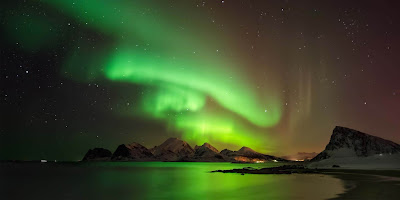What is the aurora?
What is the aurora?
Named for the Roman goddess of dawn, the aurora is a mysterious and unpredictable display of light in the night sky. The aurora borealis and aurora australis often called the northern lights and southern lights are common occurrences at high northern and southern latitudes, less frequent at mid-latitudes, and seldom seen near the equator.
While usually a milky greenish color, auroras can also show red, blue, violet, pink, and white. These colors appear in a variety of continuously changing shapes. Sometimes the aurora is as dim and scattered as to be mistaken for clouds or the Milky Way; sometimes it is bright enough to read by.
What does an aurora look like?
Auroras can appear as long,
narrow arcs of light, often extending east to west from horizon to horizon. At
other times they stretch across the night sky in bands that kink, fold, and
swirl, or even ruffle like curtains. They can spread out in multi-colored rays,
like vertical shafts of light that stretch far up into space and sometimes they
engulf the sky in a thin cloud or veil. What causes the aurora? The typical
aurora is caused by collisions between fast-moving electrons from space with
the oxygen and nitrogen in Earth’s upper atmosphere.
The electrons which come
from the Earth’s magnetosphere, the region of space controlled by Earth’s
magnetic field transfer their energy to the oxygen and nitrogen atoms and
molecules, making them “excited”. As the gases return to their normal state,
they emit photons, small bursts of energy in the form of light. When a large
number of electrons come from the magnetosphere to bombard the atmosphere, the
oxygen and nitrogen can emit enough light for the eye to detect, giving us
beautiful auroral displays. This ghostly light originates at altitudes of 100
to more than 400 km (60 to more than 250 miles)Why do auroras come in different colors and shapes?
The
color of the aurora depends on which gas- nitrogen or oxygen is being excited
by the electrons, and on how excited it becomes. The color also depends upon
how fast the electrons are moving, or how much energy they have at the time of
their collisions. High energy electrons cause oxygen to emit green light (the
most familiar color of the aurora), while low energy electrons cause a red
light. Nitrogen generally gives off a blue light. The blending of these colors
can also lead to purples, pinks, and whites. The oxygen and nitrogen also emit
ultraviolet light, which can be detected by special cameras on satellites.
Where can you see an aurora?
Auroras usually occur in
ring-shaped areas about 4,000 km in diameter around the magnetic poles of the
Earth. These rings are known as auroral ovals. The northern oval traces a path
across central Alaska and Canada, Greenland, and northern Scandinavia and
Russia. In the southern hemisphere, the auroral oval hovers mostly over the
oceans circling Antarctica, but it can occasionally reach the far edges of New
Zealand, Chile, and Australia.
The auroral ovals expand and contract with the
level of auroral activity, sometimes extending to lower latitudes to cover much
of North America or Europe when the space around Earth is most disturbed. The
complete auroral ovals in the north and south are nearly mirrored reflections
of each other, or conjugate. But it was not until the space age when satellites
could gather images the largescale auroras around both poles at the same time.How is the aurora-related to the Sun?
Auroras are a sign
that Sun and Earth are connected by more than sunlight. They indicate that
something electric is happening in space. The Sun provides the energy for the
Aurora, but particles in the aurora come from Earth’s own neighborhood in
space. The Sun’s energy is carried toward the Earth in the solar wind, a stream
of electrically charged particles (mostly protons and electrons) flowing out
from the Sun in all directions. As these particles approach Earth, they
interact with our planet’s magnetic field. This field deflects most of the
particles, creating a huge cavity in the solar wind–the magnetosphere. This
region stretches about 60,000 km toward the Sun and several hundred thousand
kilometers in a long tail on the night side, away from the Sun.
Variations in the properties of the solar wind control the
amount of energy that can leak into the magnetosphere. Here the energy is
converted into electric currents and electromagnetic energy and temporarily
stored in the magnetosphere, especially in its tail. When this influx of energy
is relatively large, the magnetosphere loses its equilibrium or balance. To become
stable again, the excess energy is released suddenly, with much of the energy
going into the acceleration of electrons. The aurora primarily occurs where the
magnetic field guides the electrons from the tail of the magnetosphere into the
atmosphere where they produce the aurora. Because the tail is on the night side
of the Earth (away from the Sun), the more intense, dynamic and beautiful
auroras occur near midnight.
You can enjoy and capture this with handy gadgets like Binoculars and Digital Cameras. Here you can buy these.
Swipe for more!
Swipe for more!






very Informative post. I love to see northern lights every time and I like Alaska northern lights tours
ReplyDeleteGreat post and thanks for sharing this information with us. To see northern lights then must plan your Northern lights trip
ReplyDeleteReally good pictures and thanks for sharing.
ReplyDeletealaskan adventure tours
best time to go to alaska
alaska bear tours
Trip to see the northern lights